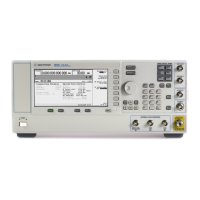140 Chapter 4
Optimizing Performance
Creating and Applying User Flatness Correction
Creating a User Flatness Correction Array with a mm–Wave Source Module
CAUTION Option 521 signal generators can damage MM source modules. Consult the MM source
module’s operating manual for input damage levels.
In this example, a user flatness correction array is created to provide flatness–corrected power at the
output of an Agilent 83554A millimeter–wave source module driven by an E8257D.
The flatness correction array contains 28 frequency correction pairs (amplitude correction values for
specified frequencies), from 26.5 to 40 GHz in 500 MHz intervals. This will result in 28 evenly spaced
flatness corrected frequencies between 26.5 GHz and 40 GHz at the output of the 83554A
millimeter–wave source module.
An Agilent E4416A/17A/18B/19B power meter (controlled by the signal generator via GPIB) and
R8486A power sensor are used to measure the RF output amplitude of the millimeter–wave source
module at the specified correction frequencies and transfer the results to the signal generator. The
signal generator reads the power level data from the power meter, calculates the correction values,
and stores the correction pairs in the user flatness correction array.
If you do not have the required Agilent power meter, or if your power meter does not have a GPIB
interface, you can enter correction values manually.
NOTE User Flatness correction is only applicable for Agilent 83550 series mm–wave source modules
and does not function with other mm–wave modules such as OML modules.
Required Equipment
• Agilent 83554A millimeter–wave source module
• Agilent E4416A/17A/18B/19B power meter
• Agilent R8486A power sensor
• Agilent 8349B microwave amplifier (required for signal generators without Options 1EA, 1EU, or
521)
• GPIB interface cable
• adapters and cables as required
NOTE The equipment setups in Figure 4- 5 and Figure 4- 6 assume that the steps necessary to
correctly level the RF output have been followed. If you have questions about leveling with a
millimeter–wave source module, refer to “To Level with a mm–Wave Source Module” on
page 133.
Configure the Power Meter
1. Select SCPI as the remote language for the power meter.
2. Zero and calibrate the power sensor to the power meter.
3. Enter the appropriate power sensor calibration factors into the power meter as appropriate.
4. Enable the power meter’s cal factor array.

